Sewing
box Index

History of sewing
boxes
Request current
list of available sewing boxes
writing-boxes
jewelry-boxes
tea caddies
sewing-boxes
contents
| |
A rare Regency fully fitted brass inlaid rosewood sewing box By R. Dalton, circa 1815.
Please click on images to enlarge | slide show | thumbnail index |
Reference: SB525
Description:
SB525: A rare early Regency shaped fully fitted brass inlaid
figured rosewood sewing box retaining its carved and turned ivory spools
and other sewing tools. The form is typical of the early Regency:
perfectly proportioned drawing its inspiration from ancient
architectural structures. It has turned gadrooning drop ring
handles and feet. The box retains its original fully fitted tray
covered in yellow paper with gold embossed supplementary lids. Circa
1815.
Origin: UK London; Circa:
1815 .
Size: 28 cm wide by 2 1.5 cm by 18 cm:
11 inches wide
by 8.5 inches by 7 inches.
Condition: good
overall; it is a real treat to find such an early box intact with its
tools which has had a long life of being cared for. Working lock and
key. See images
|
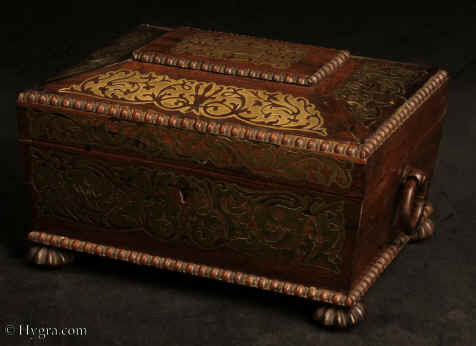
|


|
The interior retains the
original yellow silk, paper and finely gold tooled leather. Many
of the details, including the embossing are almost identical to http://hygra.com/uk/sb/sb104/
Although this box is clearly
labeled Dalton it bears similarity to boxes which are labeled Edwards.
The spools are turned and
milled ivory and bone. This form of spool with ends screwed to a
former is early 19th century and rare. It was mostly discontinued after
the first quarter of the century with the advent of more commercially
prepared thread.
See: http://www.hygra.com/sb/sbvmop.htm
and Figure 422
Antique
Boxes, Tea Caddies, and Society -- 1700--1880, ISBN:
0764316885 Antigone Clarke & Joseph O'Kelly, A
Schiffer Book for collectors..
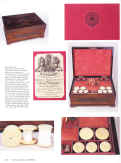
|
Please click on images to enlarge | slide show | thumbnail index |
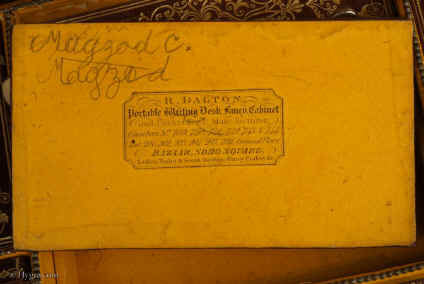
|
The box is labeled both on the inside of one of the lids
and in the document lid.:
R. DALTON
Portable Writing Desk Fancy Cabinet
and Pocket Book Manufacturer
Counters 201, 202, 203, 204, 205,-
-237 and 238, Ground Floor,
BAZAAR, SOHO, SQUARE.
Ladies Toilet &Scent Bottles Fancy Cutlery
&c.
Later Dalton labels read:
“
Dalton – Manufacturer
85 Quadrant, Regent St. London ”.
Examples of Dalton’s work always bear the hallmark of quality and
date mostly from the second quarter of the nineteenth century. (See
figure 376 in our book Antique Boxes,
Tea Caddies, and Society -- 1700--1880, ISBN: 0764316885
Antigone Clarke & Joseph O'Kelly, A Schiffer Book for
collectors., also chapter 6 and Appendix Box Makers).
|
The Soho Bazaar was London's oldest Bazaar.
"Bazaars owe their introduction into this country to the late
Mr. Trotter, an army contractor, whose vast clothing concern in Soho
Square, converted in 1815 to its present purpose, was the first
establishment of the kind formed in London; it consists of several rooms
hung with red cloth, and fitted up with mahogany counters, divided into
stands, which are occupied by about 200 females. The various articles
here exhibited for sale daily attract numerous visitors; and the Soho
Bazaar, successful from its commencement, maintains its attraction,
and has long been a fashionable lounge." (Mogg's New
Picture of London and Visitor's Guide to it Sights, 1844)
The introduction of the Bazaar into the metropolis dates from 1816,
when was opened the SOHO BAZAAR, at 4,5, and 6, Soho-square. It was
planned solely by Mr. John Trotter, with a truly benevolent motive.
At the termination of the War, when a great number of widows, orphans,
and relatives of those who had lost their lives on foreign service were
in distress and without employment, Mr. Trotter conceived that an
establishment at the hands of Government would promote the views of the
respectable and industrious (possessing but small means) by affording
them advantages to begin business without great risk and outlay of
capital. Mr. Trotter, having at that time an extensive range of premises
unoccupied, without any idea of personal emolument, offered them to
Government, free of expense, for several years, engaging also to
undertake their direction and management on the same disinterested
terms. His scheme was, however, considered visionary, and his offer
rejected. Mr. Trotter then undertook the responsibility himself; the
Bazaar was opened 1st February 1816, and by excellent management, the
establishment has since flourished; this success being mainly
attributable to the selection of persons of respectability as its
inmates, for whose protection an efficient superintendence of several
matrons is provided. The counters are mostly for fancy goods, and to
obtain a tenancy requires a testimonial respectably signed. The success
of the Soho Bazaar led to establishments formed by private individuals,
but with only temporary success. (John Timbs,
Curiosities of London, 1867)
See: http://www.victorianlondon.org/shops/bazaars.htm
|
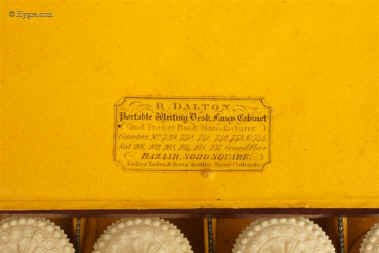
|
Please click on images to enlarge | slide show | thumbnail index |
The six spools are turned and
milled ivory and bone. This form of spool with ends screwed to a
former is early 19th century and rare. It was mostly discontinued after
the first quarter of the century with the advent of more commercially
prepared thread. The box also has a tape measure and a waxer.
|
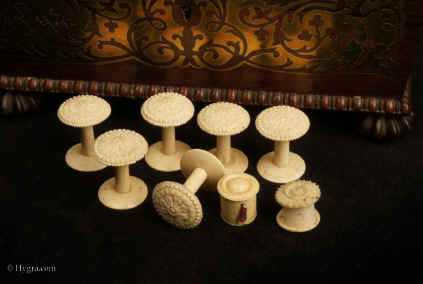
|
Please click on images to enlarge | slide show | thumbnail index |
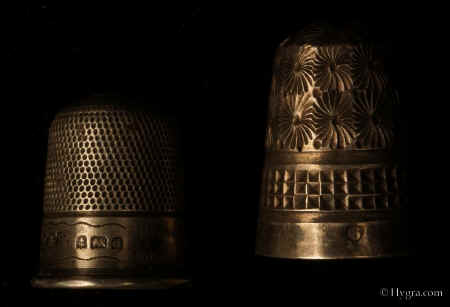
|
The thimbles are later than the box.
|

|
Inside the lid there is a
panel of rushed yellow silk framed by gold embossed maroon coloured
leather. A catch holds the panel in place. There is a document
wallet behind it.
The interior retains the
original yellow silk, paper and finely gold tooled leather. The lyre is
a reference to the music of Rome.
|
Please click on images to enlarge | slide show | thumbnail index |
The design of the inlay
is of highly stylized flora, suggesting neoclassical designs hinting at
palmette and (on the top) acanthus motifs. The juxtaposition of dark
wood with bold brass inlay was popular in the early part of the 19th
century. The wood and the bright brass were mutually enhancing. The
Prince Regent (later George IV) commissioned such work for his Royal
palaces. This technique, which perfected control of cutting and
inlaying, required time and skill and it was very expensive at the time.
It is no wonder that such work was popular at a time when excess was
rife and style was given supreme social importance.
|
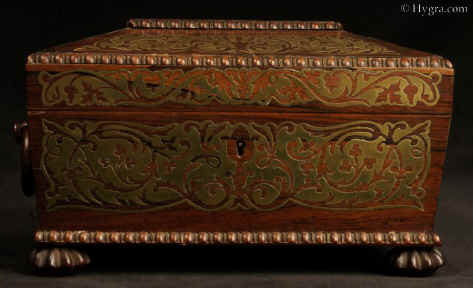
|
Please click on images to enlarge | slide show | thumbnail index |
Please click on images to enlarge | slide show | thumbnail index |
| Detail: turned rosewood drop ring handle. |

|
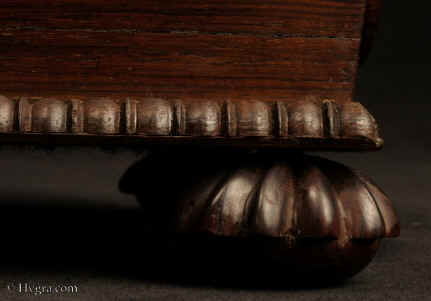
|
Detail: the gadrooning and one of the turned and
carved feet.
|
Please click on images to enlarge | slide show | thumbnail index |
The design of the inlay
is of highly stylized flora, suggesting neoclassical designs hinting at
palmette and (on the top) acanthus motifs. The juxtaposition of dark
wood with bold brass inlay was popular in the early part of the 19th
century. The wood and the bright brass were mutually enhancing. The
Prince Regent (later George IV) commissioned such work for his Royal
palaces. This technique, which perfected control of cutting and
inlaying, required time and skill and it was very expensive at the time.
It is no wonder that such work was popular at a time when excess was
rife and style was given supreme social importance.
|
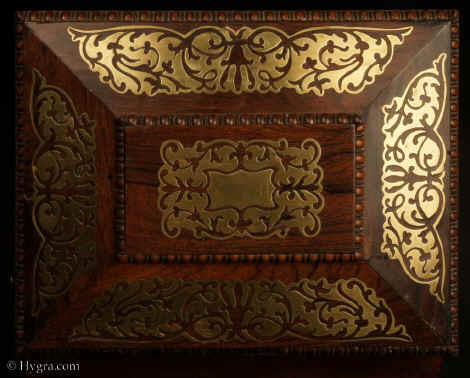
|
Please click on images to enlarge | slide show | thumbnail index |
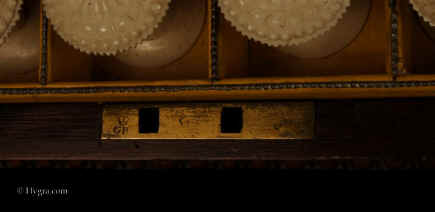
|
The lock plate is stamped with a crown and GR. and the word
"patent)
GR is used to indicate that George was King when the lock was made.
The lock works and has a key.
|
Please click on images to enlarge | slide show | thumbnail index |
All text and images and linked images are ©
1999-2010 Antigone Clarke and Joseph O'Kelly. If you require any further
information on permitted use, or a licence to republish any material, email us
at copyright@hygra.com
|
